fieldnotes
A sporadic report on poetic observations. An email newsletter loosely focused on our radically changing ecosystems and the built environment. Lots of rambling, both in the walking sense & the talking sense.
Sign up Here.
◬

A view from the abandoned pier on my daily walk along the levee in my new neighborhood of the Lower 9th Ward, New Orleans, LA. The “Central Business District (CBD)” of New Orleans can be seen beyond the Mississippi. 09.07.2024
FIELD REPORT
A VIEW OF THE WORLD FROM THE LOWER NINTH WARD
Its one of those purgatory mornings, gray, even light making everything flat, crisp, melancholy. Wisps of fog cling to the low inland slope of the levee, the crunch of gravel underfoot the only sound other than the occasional sloshing of the waves on the banks, wakes from the passing barges on the Mississippi. Sometimes the city skyline over there across the river looks sort of heroic, grand even, like a bygone, adolescent New York viewed from some longshoreman’s boat out in the Meadowlands of New Jersey (one imagines). But today it looks sort of pathetic, frail, small, not a “real” downtown— and wholly inappropriate on this flat, wet, horizon. I’m grateful to live here, in the part of the lower 9th that borders the river; one of the few places in the city you can maybe forge a real connection with the water, get a glimpse, a ghost image, really, of what the delta might have been like in its early days.
Because I am downriver from the port, and because of the proximity to the Industrial Canal that connects the River to Lake Pontchartrain (and cuts me off from the rest of the city) I am ensured regular traffic of staggeringly large boats. This, too, feels like a view rarely given which I feel lucky to receive; a peek behind the curtain of the constant churn of global petrocapital trade. Seeing these whales of boats, like whole cities crushing towards you, blotting out the sky, materializes just how much damn stuff we collectively consume daily.
Sometimes men are fishing off the abandoned pier, their coolers full of fat, long, possibly-polluted catfish. I worry about the pollution, heavy metals and the like (what with this being a long-industrialized waterway and at the end of a massive watershed, the collection of half of America’s waste water and runoff), especially because I assume I’ve eaten these catfish in my poboys already. In spite of, or perhaps because of, this paranoia I think I’ll get my fishing pole set up (Thanks again, Jonathan!) and join them one morning as I pass. Again, to materialize the reality of consumption, of eating fish. This is something new for me, following nine years of vegetarianism, and I want to catch and prepare some with my own hands. Today the pier is silent, wind-swept, with only faint bloodstains marking where the fisherman usually stand. The horrors of our post-ecological world: to fear the very river which gives me my drinking water, to see fresh fish not as bounty but as potential poison. And not just here, but everywhere: everything is both vital to life and a hidden, slow death. You cannot avoid the plastics. A biological rejection at the cellular level of our way of life. And so we joke about it.

One of the pair of “Steamboat Houses” found along the banks of the Mississippi in my new neighborhood, also known as Holy Cross. 09.07.2024
On that topic (i.e. jokes about the horrors of contemporary life) I’ve been thinking maybe I should re-read White Noise. Some enterprising romantic has hung a nice, sturdy swing from the Channel marker, a large, two-story metal structure with a bright orange triangular sign offering the number 2 for the passing boats. It is perfectly oriented for sunset, plus the buildings of the CBD offer protection from the harsh red ball of sun, so you can enjoy the changing gradients of the firmament without harm to your eyes (as much). Here is another instance of beauty and the unknown ills of the world—like a moth to the flame. I remember that from White Noise; the potent symbolism of these otherworldly sunsets after “”The Airborne Toxic Event,” which is why maybe I was thinking of it as I walk to this, my new sunset spot. It deals with invisible perils.
I direct my attention, most of the time, not to the modern mass of buildings but to the subtle hint of the French Quarter, the spires of St. Louis Cathedral visible if you focus, and pretend I’m standing here before all this; before the channelization of the Mississippi, before the tall buildings, before the 1,770+ active oil platforms and web of associated pipelines out in the Gulf. This sort of intentional myopia is fun (and certainly vital for tourism in New Orleans), but the ugly truths of the region have their own insidious draw, aesthetically, and are a significant part of the reason I moved here. And so much of my exploration of this place since moving four months ago has been informed by this pendulum swing between massive infrastructures and quotidian beauty: the sublime power of the Surge Barrier on Lake Borgne, the mystery and humanness of finding some sort of spiritual offering left on the levee on my walk.
I believe that New Orleans is a place in which vital questions about the future of architecture, ecology, and governance might be asked, and with humility, attempted to answer. It is a place of both singularity— an urban island amid fecund bayous and ghost cypress stands— and incredible diversity; a roiling pot of long-held cultural traditions, emergent cultures, changing demographics. New Orleans is a city of contradictions, like a myth from Invisible Cities. It is terra firma where none should exist; a modern city in an alluvial delta constantly battling to remain (as anyone familiar with its potholes will attest). It is both a backwater town and an international destination. A place of shared cultures yet intense segregation. Its built environment ranges from quaint shotguns and Creole cottages to massive infrastructures like levees and surge barriers. It is simultaneously not recognizably American and quintessentially so.
Engaging with the built environment here means engaging with obvious challenges—flood resilience, hurricane preparedness, historical context—but also envisioning how to live differently in the face of climate change and how our lives will evolve accordingly. I could go on about why I chose to move here, and why I am grateful to call it my home, but I’ll just say this: Amid increasingly homogenized global cities, New Orleans remains distinctly its own. And so these two thick chains and a plank wood, a simple gift to the neighborhood, warms my heart each time, childlike, I launch into the air. The swing reminds me of the joy I found on my first visit to New Orleans, some 6 years ago, and reminds me why I am here today: beyond all this positioning, I just love it here.
RECOMMENDED ENCOUNTER
WATCHING FLOATING PLANTS

Location marked by a star is the very end of the former Dump at the end of Florida Ave. where I found the ruins of an old dock and hang-out/ hunting camp and sat and watched floating plants for a while.
Earth is a place where you can still lose things. But its becoming increasingly less likely, and that is something I am concerned about. I’ve been revisiting James C. Scott’s Seeing Like a State. The nutshell summary is that statecraft is integrally tied to the knowability of people, and thereby taxation and control of them, which historically has been achieved through sedentary lifestyles. Basically, Scott argues that farmers are easier to tax than nomadic peoples. Seems simple, but when you apply the logic to more complex societies like our own you see it everywhere.
What I’m trying to get at, I guess, is that I fear this same “knowability” mapped onto the physical surface of the Earth. How fantastic and strange that we can see an entire image of the world, and zoom in to any part of it, with a few clicks on our phone or laptop. Google Earth/ Google Maps has radically changed our perception of the world, I’d argue, and will only continue to do so with advances in things like LiDAR scanning and AI analysis of satellite imagery.
Sedentarianism will no longer be this vital force of state power. Indeed, this is kind of the whole premise behind Starlink and recent trends in “Digital Nomadism”: to have a fully connected world. Which sounds radical, freeing. But in practice, at least for me, results in further destabilization of community producing a further radically individualized (and thereby capitalistically efficient and profitable) existence. To be able to live a neoliberal capitalist lifestyle anywhere on Earth’s surface isn’t freedom, its destruction through homogeny. This is actually one thread in a larger question about how we perceive the Earth which I am currently trying to write a book about. So, I’d love to discuss more if anyone has thoughts on all this. (I told myself I’d write a book before I turn 30, which happens on May the 19th, giving me exactly 132 days. Hold me to it!)

All to say, I was thinking about movement and how it relates to governance and our understanding of the world when I was sitting at the edge of a former city dump, a huge, abandoned peninsula of land sticking out into what remains of Bayou Bienvenue, and I noticed these clumps of water hyacinths (Pontederia crassipes). Brought to North America from their native South America as an ornamental, it is now a particularly competitive invasive, notoriously hard to remove and fast to reproduce via cloning through runners. A la Anna Tsing, what might this tenacious plant teach us about nomadism and fecundity?
I sat for a long time, risking walking back in the dark with the wild pigs (I saw many rooting spots on the walk out), watching and photographing these moving plants, which, through their movement, evade some level of qualification.
 Mapping fails when applied to even just a few minutes of this floating plants passing by. There are too many of them, their movements too constant. They travel in packs.
Mapping fails when applied to even just a few minutes of this floating plants passing by. There are too many of them, their movements too constant. They travel in packs.WORKS IN PROGRESS ADMINISTRATION
ST. JEROME AND THE QUEST FOR HABITABLE FURNITURE

I’m looking to make myself a desk. Obviously, this is an overcomplicated undertaking for a designer. I’ve been looking at paintings of St. Jerome lately for inspiration. Part of the canonical representation of this particularly studious saint, besides a lion, is a book-strewn desk. I think it must have been a seductive subject for artists of the Renaissance. It gives a moment for them, still within the framework of religious iconography in which many were required to operate, to reflect on their very practice as artists. An atelier, a study, a desk, a studio, a room of one’s own. I love to compare different versions and imagine the artists approaching it as an exercise in creating the Platonian desk, their own perfect setup. The Barbie Dream House of a desk. I’m already running longwinded, here, so I won’t muse further on it. I’ll just share some of my favs:

Durer, 1514

DHendrik van Steenwijck the Younger, 1624

Antonello da Messina, 1474
I’ll also ask that if any of this sort of “part-room, part desk” sort of furniture comes to mind I’d be so grateful for recommendations. I’m trying to share W.I.P. work and early thoughts more in this newsletter because I think its fruitful ground for collaboration! There’s definitely some sort of project brewing, here.
Commission me to build you an authentic replica of the desk portrayed in Antonello da Messina’s version of the painting! This would be like my dream design-build job rn lol. I’ve already started 3d modeling a speculative version of it (WIP below).

POETS ANONYMOUS
A COLLABORATIVE POEM
by C.A., H.T., M.M., and Anon
The heady scent of flowers too ephemeral to name,
the mess I left for someone else,
the tiny, sweaty forehead nestled in the crook of my arm
balanced so delicately that I can’t reach
my room temperature, mediocre coffee
tapping nerves,
low humming beats, the bumps on the road heading north I-5
an oncoming storm, rain falling, the wood pecker in my brain,
Squinting and turning to face the breeze and sunbeams,
the manta rays breech for joy, obviously.
The above being the collaborative poem, submitted in parts by readers from my call in the last issue of fieldnotes. That you all so much; it was lovely to hear from each of you and catch a glimmer of your life.
Perhaps we should do another one? I am interested in how our seemingly disparate lives can find cohesive rhythms side by side like this. And a big part of the reason I started an e-newsletter was to connect with friends in a more intimate, real way than social media typically offers, so making (potentially bad) poems together seems perfect. Perhaps this time it could be that anyone interested submits a self-contained (rhyming or not) couplet (i.e. two lines of verse)? Which would then assemble, as feels most fitting, into a longer collective poem. Here’s a link to submit if you feel moved to.
ENDORSEMENTS
READING, EATING, LISTENING
Reading
I am currently re-reading To The Lighthouse by Virginia Woolf. When I first read it, I was 23, and I recall the beauty of the writing coming through, but feeling ambivalent about the broader themes of the book. I feel like what I picked up on was the 19th century gentle society and read it in a sort of straight-ahead (boring) way. But it is really quite an experimental work musing on society, feminism, and existential issues; honestly blowing my mind right now. I think age has brought me to a place I can really value the book’s themes— time, the unknowability of others, the inner-narratives, our own peculiar distortions of time and space which guide us all. There’s a section I remember in which time’s degradation on a long-shuttered house is described and mused upon which I’m really looking forward to revisiting (as you know, architecture and all, I think a lot about the poetics of the built environment).
On deck is Ulysses, another book published in the 1920s which is particularly attuned to time. I’ve been telling myself I’d read this (and moving with a chunky copy) for years. If you’re at all interested in reading along as shared accountability, give a shout.
Eating
Those not local to New Orleans may be surprised to hear that, alongside the multitude of Cajun classics, the city has fantastic Vietnamese food. After the Vietnam War, many of the United States’ South Vietnamese allies immigrated to the U.S. and a large number found a new home, and new market for french bread, in New Orleans. (In part thanks to Catholic Charities and the shared french-tinged, Catholic heritage of both Vietnam and Louisiana. So much to reflect on here in terms of shared and divergent cultural identity, colonialism, globalism…) Dong Phuong Bakery is the most famous of the many Vietnamese restaurants in the area, in particular for their version of King Cake. I tried it (not the King Cake, though it is now of the season!) for the first time a couple days ago after a visit to Bayou Savage. They have a vegetarian “beef bulgogi” Bánh mì that was so damn good, and for $6.50 no less! Also really enjoyed trying the “Yuca Silkworms” which were like gummy worms but really soft and mild tasting, and made of mung beans and Yuca powder.
Listening
Been playing the album “Send Flowers” by State Champion a good bit this week. Really great lyrics, delivered in like a channeling of David Berman (Silver Jews) from the spirit realm.
Also, I finally got around to listening to my housemate Duncan’s first record and I’m so upset I waited! Really fantastic: funky, complex, fun. His favorite artist is Prince, which definitely comes through in a great way. The production rocks, lots of cool 80s synth sounds, funky guitar pops, even a smooth sax solo. It is called “Accelerator” by The Convenience.
PHOTOLOG
NEW ORLEANS & MARYLAND AUG ‘24 - JAN ‘25

Most photos I will feature in this section are from walks, but this first one is out my car window on my drive from Los Angeles to New Orleans back in August. A first glimpse of some cypress swamps in Texas. I’m looking at getting a sea kayak, which will allow me to really put in some nautical miles exploring this ecosystem and take overnight kayak camping trips.
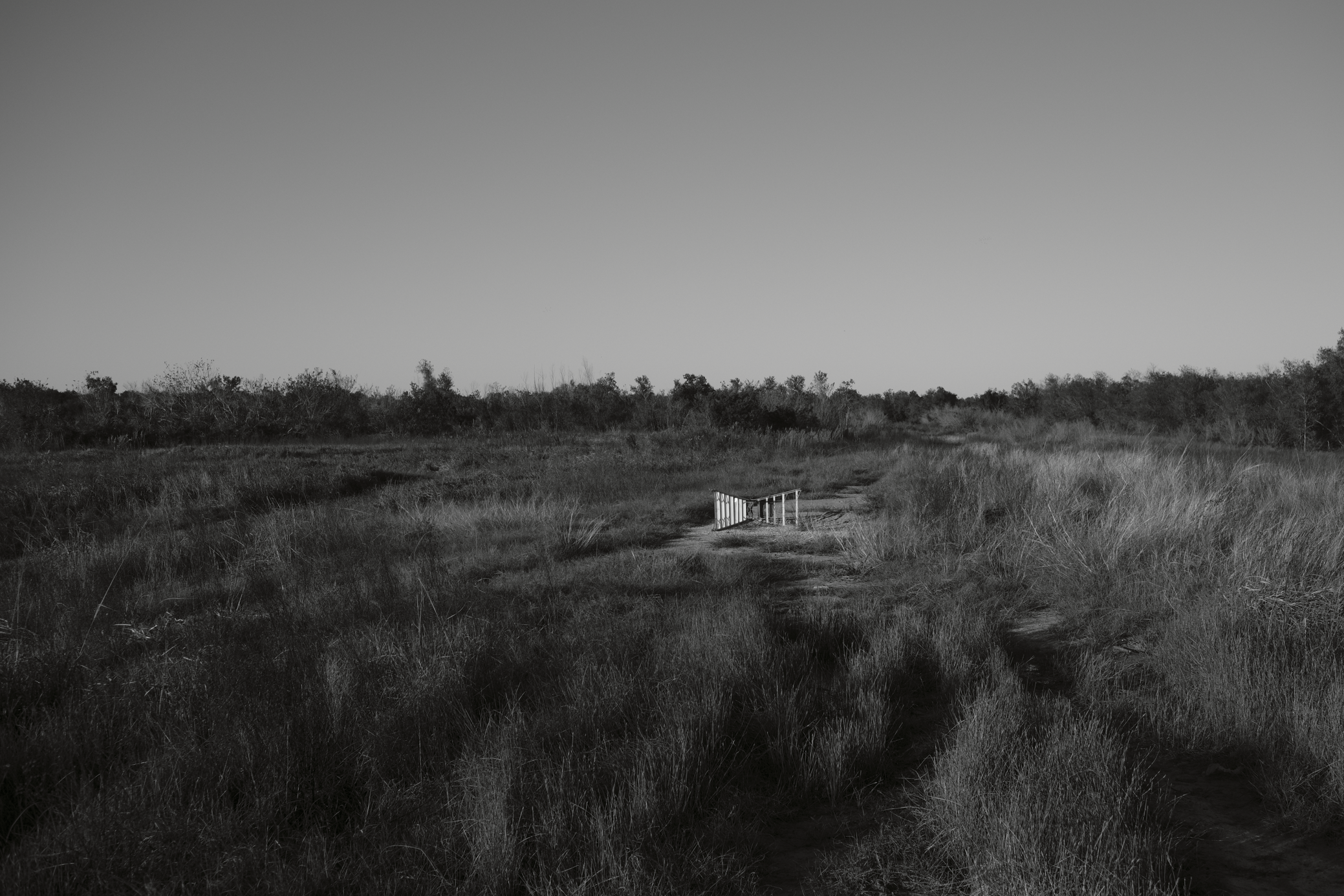
This ladder out on the stark landscape of the former city dump felt like a perfect readymade found sculpture, especially at this angle

Chris shucks an Oyster while Jonathan goes for a piece of fried Red Drum that he had caught in the Chesapeake earlier this year. Four of us put down nearly a bushel of Chesapeake and Chincoteague oysters on Thanksgiving eve. Felt really restoring and revitalized my connection with the Tidewater, which I miss dearly.
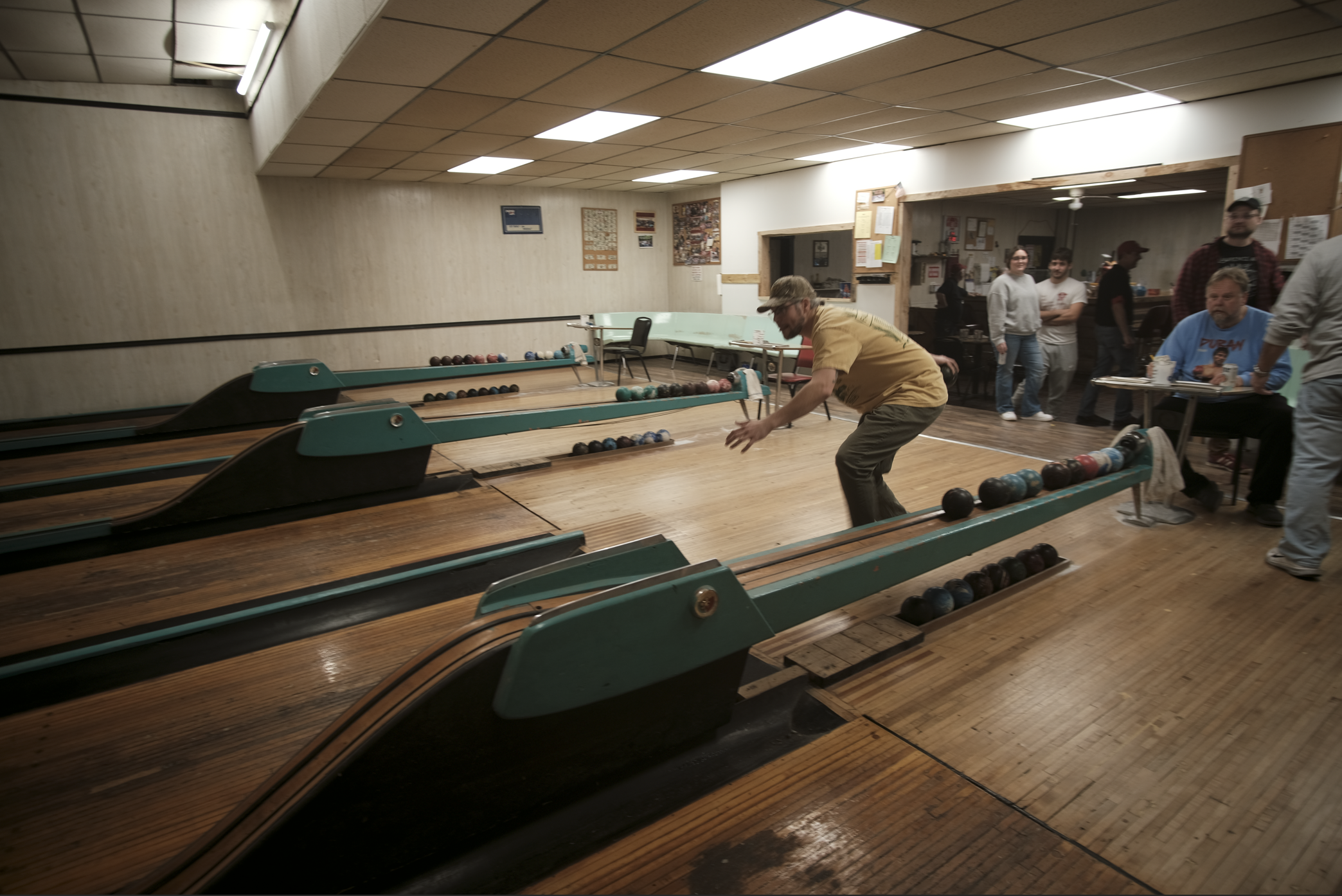
When I was back in Cumberland I tagged along with Casey and Gabe to their duckpin bowling league. This place doesn’t have machines to reset the pins so “Pin Boys” have to hop down and do it by hand (!)

A portrait of my Great Aunt Mary, now 92 years old.
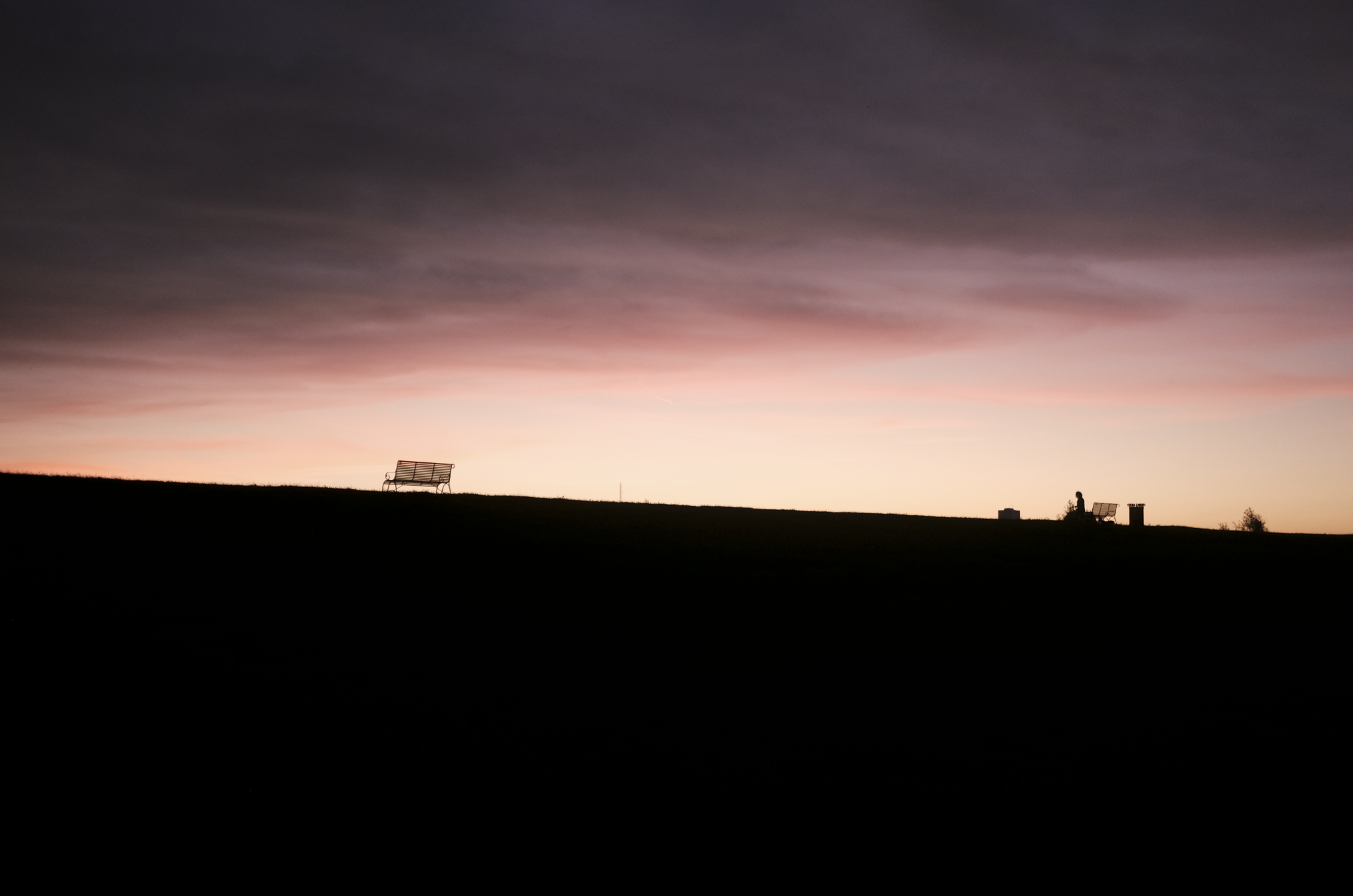
I love the feeling of walking up the crest of the levee to reveal the sunset and I feel like this photo really gets at the feeling, which is sort of hard to describe.
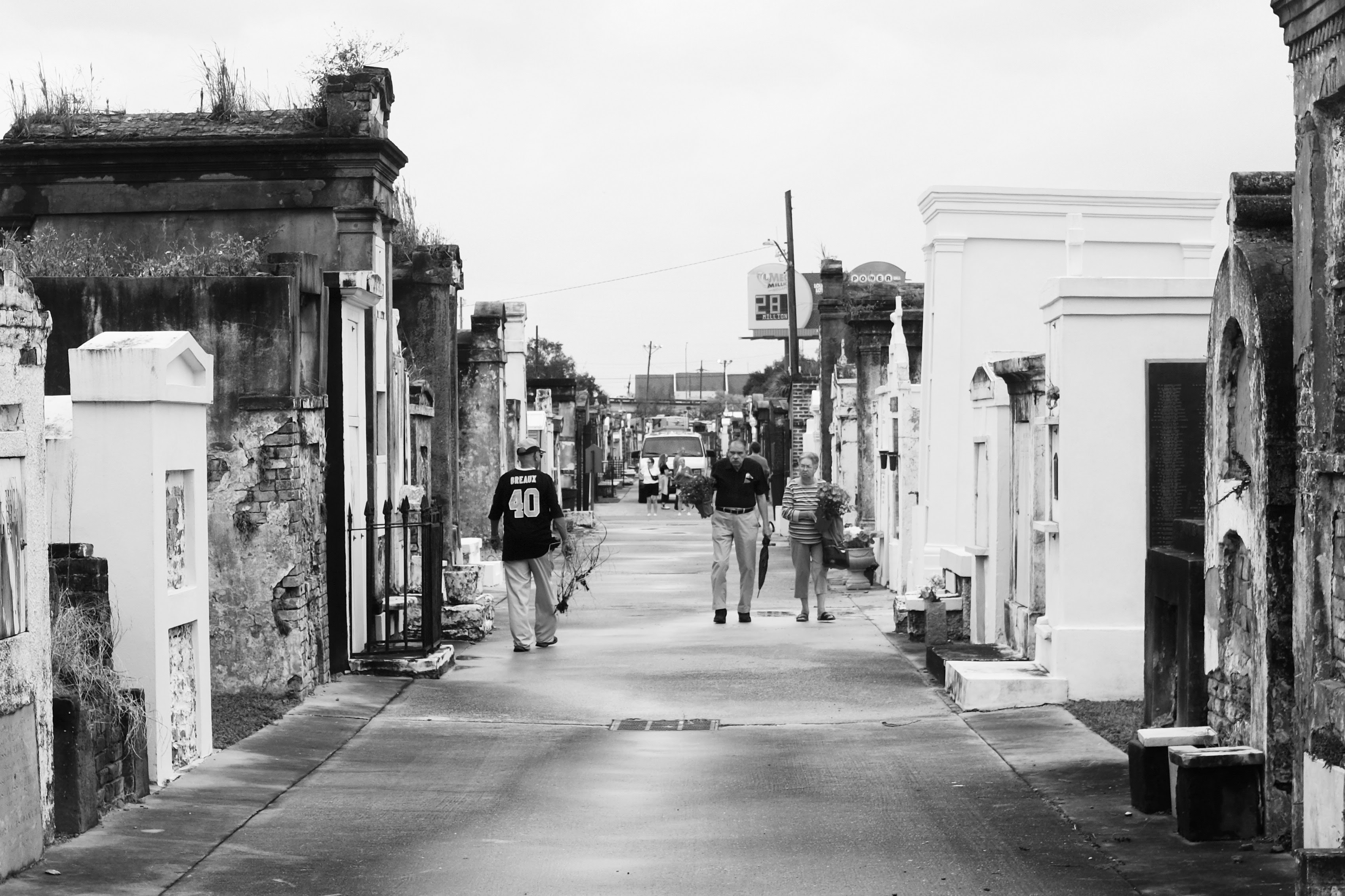
A visitor wearing a Saints jersey to St. Louis Cemetery No. 2 carries an uprooted weed after cleaning a grave as a couple arrives with fresh flowers on All Saints’ Day. I liked this dichotomy (old/ new, dealth/ life) which is further accentuated by the surrounds of the cemetery itself. Ever present is the drone of the I-10 highway overhead, and general urban bricolage creates a jarring backdrop for the historic tombs. (e.g. a billboard for the Mega Millions can be seen in the background).

One of the more overgrown tombs in St. Louis No. 2 on All Saints’ Day.

Speaking of the Liturgical calendar, last night kicked off Carnival, being the start of the Epiphany, or 12th night. This is celebrated in New Orleans with a parade dedicated to Joan of Arc, a charming and wholesome walking parade with lots of Gothic French grab that I attended with my housemates Maggie and Sam and their friend Steven.

My first New Orleans parade, though, was a Second Line which went through my neighborhood a few weeks back!

One more from the Joan of Arc parade last night: this woman was just a spectator but really went all out with her Golden Church Head. I’ve got to start planning my costume for Marti Gras because this city goes all out.
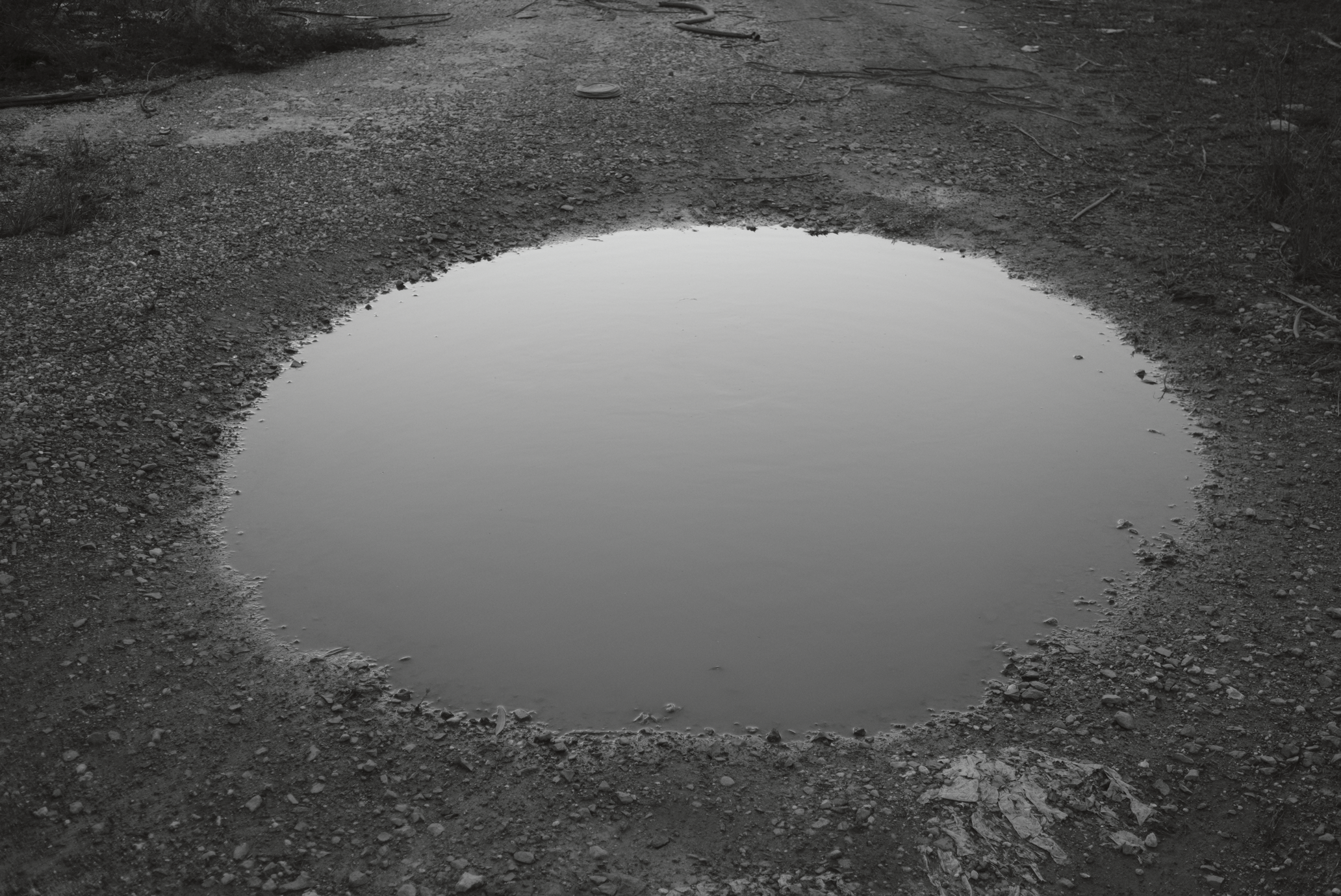
Not much to say here, I just really liked how round this puddle was! Sorry I rambled so much, yet again. Until next time, friends. Stay in touch :)
May the Sun Shine Upon You!
◬
◬

|
I last wrote in October, in New Mexico. Since then it has been the crossing of Arizona, nights in truck stops, nights in the quiet of a pull off on a dirt road in the lightless desert, some passing friends and a few naked plunges in the Colorado at the bottom of the Grand Canyon. Some crying at the wheel, and screaming. Reminiscences of my time on the Pacific Crest Trail as I coddled my transmission through Cajon Pass. Stopping to crush some sagebrush in my hands and rub it on my body. Thinking about The Grapes of Wrath and unironically blasting “California” by Phantom Planet two times in a row as I made my way down to the greener pastures of coastal Southern California. |
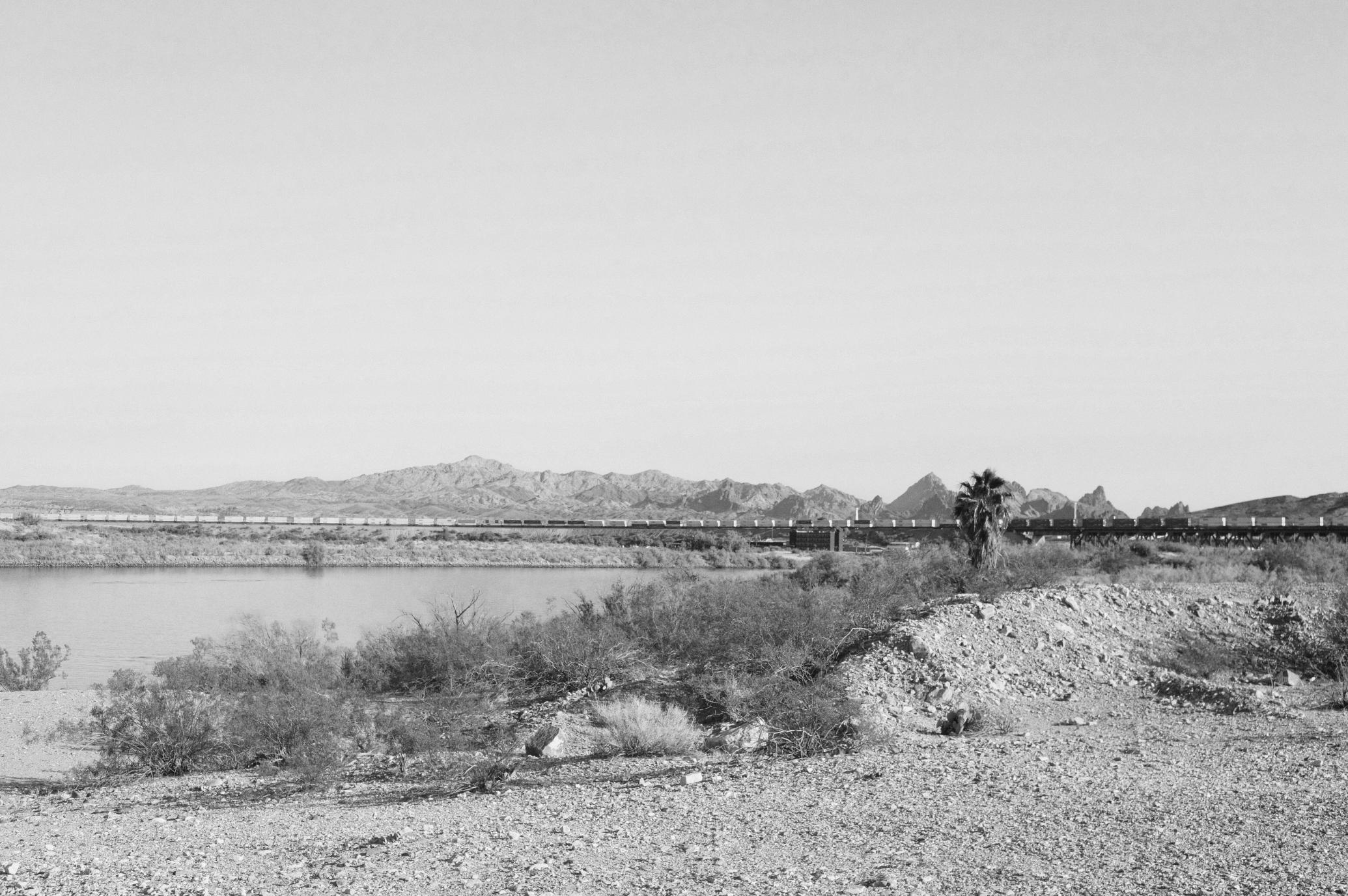
A train crossing the Colorado at the border between Arizona and California
The past 6 months, somehow, have been Los Angeles. The joy of discovery, mania, perplexity, and then malaise. An impossibility of capturing, or locating, the place, other than perhaps in the occasional picturesque diner or donut shop, the shadow of a palm tree, the streetlights of Western Ave stretching ad infinitum to the sunset-scorched horizon as viewed from up on high at Griffith Observatory.
A fog of hot days and job applications and nowhere to be. Sweating by a weedy patch of the LA river writing bad songs on guitar leaning on the hood of my van. Drinking far too much, too often alone. Also some ups; great live music and the hint of a future community, discovering the unironic joy of the very nerdy sport of disc golf with my friend Mike, some writing for the LA special issue from the New York Review of Architecture. Then a new apartment (a room in a large artist loft space within a former Pabst brewery and only accessible by not one, but two ladders) and finally, spurred by being nearly completely broke, a new job (construction manager). Mediocre dates, some better ones. Nice solemn walks scented by jasmine. Eavesdropping on conversations in Spanish, not understanding, but appreciating the cadence, the texture, of a new language. Nice, quiet beer over a book at one or the other of the two pseudo-European hip cafes I like. (In America, we use European as adjective for the rare bar where there's actually good, affordable wine and you can sit outside. As we all know a shockingly high bar). Smoking more cigarettes to fuel nights spent attempting to make friends in this new place. At some point, Death Valley.

A family wandering in the “Devil’s Golf Course” of Death Valley

Joseph and Charlie smelling the chaparral ( Larrea tridentata, aka creosote bush) in Grapevine Canyon in southern Nevada
And sweet friendsgiving Thanksgiving in Nevada with my college windsurfing buddies ft. my first wobbly attempt at windsurfing in like 7 years. A Christmas drive across country (2500 miles in two nights, an audiobook of Whithering Heights, three red bulls). One Taco Bell after another.
Back West for the rest of winter, fiddling with my keyboard, my banjo, my guitar, “I’m going to really try to make music.” etc etc. A couple weeks where I was trying to write short stories. Then I bought sign-painting brushes. Too many commitments I will fail to uphold, and a real reckoning with my own failures. An astonishing amount of TV as neural numbing agent. A week where almost all I listened to was “These Days” by Nico (and written by Jackson Browne) on repeat.
These days I'll sit on corner stones
And count the time in quarter tones to ten, my friend
Don't confront me with my failures
I had not forgotten them

My new home visible across from the neighboring railyard, the smokestack acting as landmark for the former brewery complex turned artist live-work space dubbed "The Brewery" |

| An shot of the factory floor in its heyday, shown to me by my roommate Jacob. We can see our loft in it, that tile floor is our floor, the distinctive light fixtures our light fixtures. No remnant smell of the ghost of beer, though, and probably for the best. |

my current home, my room being the one at the top of the tower of rooms built by Jacob.
More of too, too many beers alone. The beers had the company of nostalgic TV programs (X Files). Anything to not be myself for a while. The undoing of my mind, undersleeping, then oversleeping, all fluctuations within the base chemical cycling of alcohol to coffee with nicotine as bridge. I blame it on the 9-5, or this excessive drinking, my mind coming apart. But it's really something more fundamental and damning. It came on slow, then ramped up. My thoughts were erratic, strange, and alarming. The prolonged self-induced numbing turned into a fracturing, a disintegration. It ended with me checking myself into the ER, convinced I was losing my mind. I was told I was fine, with a 500 dollar bill to show for it. Not that this really calmed me.
Desperate, I quit drinking, quit cigarettes, quit coffee, quit Instagram, quit everything, basically. I left my phone in a drawer and drove to the desert.

The arm of your friendly neighborhood hypochondriac as he awaited a complete and permanent mental dissociation which never fully arrived.
In Joshua Tree, getting baked by the sun, filming the light on the rocks and myself moving around, jumping, yelping. Eadweard Muybridge’s “The Human Figure in Motion” (1887). Or something like Bruce Nauman, simple existence as creation. Reading The Goodby People by Gavin Lambert (second I’ve read of his about various characters of LA, the first, Slide Area, set in the 50s and this second one, in the early 70s, both great, and part of my self-made series of reading fiction set in my new home of Los Angeles) in one sitting, on a large, sandpapery-yet-comfortable rock. Slowly, a returning to a more stable condition thanks to the sun locating me. It and the rock, my anchors.
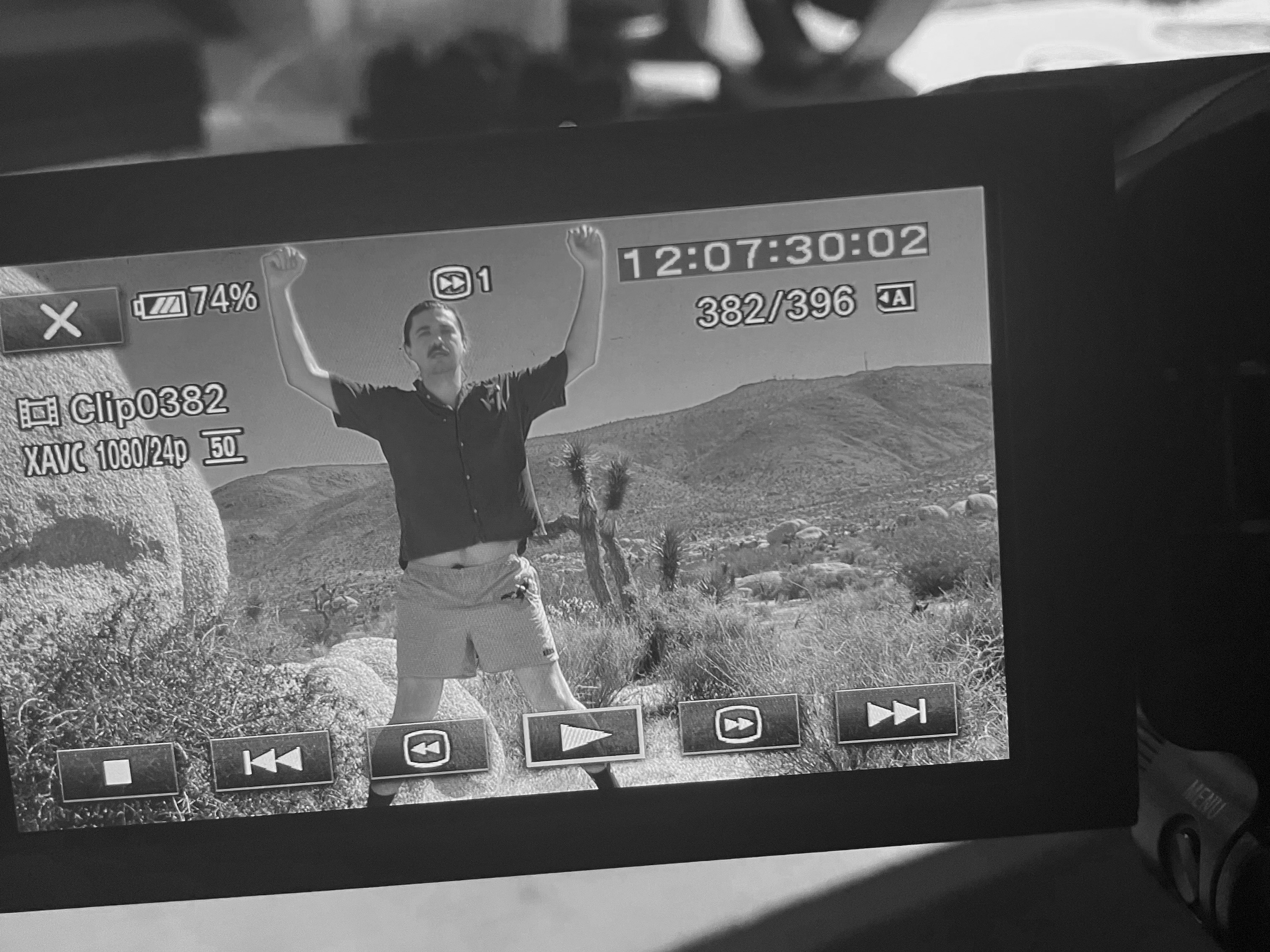
Stomping around the desert
A sunset walk, reading an information plaque about deep time and the evolution of desert flora somehow making me uncontrollably weep. This was followed by an unbelievable feeling of peace, of acceptance, and of love for everyone I saw, a deep empathy for the world. No way to write about this without sounding "woo woo" but it was real. I've been slowly improving since this intense awakening. I’ve been trying to hold onto it as long as I can.
I've been doing this, i.e. holding onto reality, by avoiding my phone. I am seeing that though alcohol certainly played a large role in my unease, the damn phone is probably just as bad. When not looking at my phone or the internet, I've:
- Read Speedboat by Renata Adler and liked it. It didn't move me, perse, but was well written and had some real hitters in terms of interpretations of interpersonal relationships in the modern age. Also, just a fascinating capsule of the life of a (tired) extremely cosmopolitan New Yorker in a different age and specifically capturing a sort of removed mental state achieved through a sort of cynical gaze from ones' own life which may feel familiar to some of us.
- Spent time in the sauna. The things which have most helped me, been most relieving and life affirming, are physical ties back to the body; laying in the sun, stretching, meditative body scans (I’ve been listening to this one a lot.) The sauna particularly has been my savior. It is simultaneously social and reverent, quiet and intense, profoundly of the body and yet brings about a sharp mental alertness. It also makes me feel my humanity in a deep time sort of way, soaking in heat being such a time-honored social practice: badstu, onsen, banya, sweat lodge, temascal.
- Gone to the movies alone (a really wholesome, lovely and treasured activity for me which is a perfect blend of nostalgic childish joy and bygone ripened bachelorism. Think The Moviegoer). Most recently, Civil War. I thought Ex Machina was an extremely well crafted, thought provoking, and entertaining movie. I distinctly remember being excited to see what else the director would do. Somehow I’ve missed two of Alex Garland’s since then (but by the reviews, might not have missed much). I finally saw Civil War last night, and I’d describe it exactly the same. Just a really good movie, the first I’ve seen in theaters in maybe a year that's really delivered.
- Listened to, and attempted to write, music. This week I've really been loving Colour Green by Sibylle Baier. A collection of bare, haunting songs, discovered by the son of an unknown 1970s folk singer, which were burned to CD by him as gifts to family members. According to Wikipedia lore, he gave one to J Mascis of Dinosaur Jr. who encouraged the Orange Twin record label to release it, which they did thankfully. The first track, "Tonight," is particularly great.
Apologies for this fairly monotonous listing, but it has been helpful rambling away here as a reminder of good things to be had off the screen. Its pull is strong. I've been playing online chess on my phone which I justify as a less toxic activity than doomscrolling but which still fuels the insidious power of the device. Just the object of the phone, checking it, holding it, has a sort of addictive magnetism which disturbs me.
Right now, though, I am feeling light and hopeful. I just got back from Galco's Old World Grocery in Highland Park. An old, linoleum-floored store full of special sodas and bygone candy bars, I come here for a feeling of wholesome comfort. The check out girl carries kind eyes in a humble, self-possessed sort of way, and the last time I was in the older gentleman who probably owns the place talked to me about red peach jam, and how the red peaches are grown in France with grapes intertwined into the trees because they are a late season fruit and can be harvested at the same time. But they don’t keep well, which is why they are made into jam. All of this with Danny and the Juniors' "At the Hop" (1958) playing from the crinkly loudspeakers. What’s a better cure for depression than chatting with the kindly and idiosyncratic elderly? Plus, you can try fun treats like the “Idaho Spud.”

!!READER PARTICIPATION!! A COLLABORATIVE LIST POEM
In wrapping up this ramble, I thought it’d be fun to ask you, my dear reader(s), to participate in fieldnotes. I’ve been making list poems every day of notable events, memories, feelings, of the day. I thought it might be fun to make a collaborative one! If you feel so moved, email me a single line (could even be a single word) of something notable in your recent flow of experience. For example, a few days ago I woke up to an absurdly loud crowd of parrots. So I might write:
The screeching din of parrots on a cool Altadena morning
These various moments will be strung together as a list. For example:
pine needles, the drone of a nearby lawnmower, the smell of a vaguely familiar perfume, sun spots beneath closed lids, a turmeric-stained wooden spoon,
Please feel encouraged to submit multiple entries to the list, if you feel so moved! And send along if you’d like me to include your first name, initials, or retain anonymity in the byline.
Speaking of collaboration, for those of you in the Los Angeles area, I am contemplating putting together a little rambling club for those of us who love nothing better than ambling about aimlessly exploring. Like the rambling clubs of 20th century Britian, I'd imagine it to be of a socialist bent, perhaps as a semi-curated platform to discuss the politics of space. In short Book Club + Walking Group + Art Project. Would you join the L.A. County Ramblers? Space Walks? The Space Walkers? More soon!
SOME PHOTOS OF LOS ANGELES AND SURROUNDS
In the past I've really felt color photography was far superior to grayscale, but I am coming back to it as you can see. I've been feeling so over-saturated lately, is part of it I think. I think it is also because I read Rings of Saturn by W.G. Sebald and was really taken by it and its sparing use of low-quality photos from his long fugue-like walk through European history.
I usually end these emails with an apology for, yet again, rambling in a diaristic and self-indulgent way about nothing in particular vs. presenting a few interesting tidbits I've come across with brevity (and levity) which I think is my ultimate goal. But I think this is just what my fieldnotes are, typically, if I am being honest. Why am I subjecting others to them? Exhibitionism? A sounding board? Juvenile ego-fueled self-aggrandizement? I think, primarily, accountability...To try to write a bit, such that eventually these might not be embarrassing anymore because they actually WILL have a clear structure. And to risk the embarrassment of candid over-sharing as an in-road to real connection with others. And that I might have some external record of time passing for myself, which feels extra important in the timeless summer here in LA.
Anyway, I will part ways with a poorly curated smattering of photos I made on recent walks around LA. Until next time, my friend! ◬




















MAY THE SUN SMILE UPON YOU!
|
|
Hello, friends. I hope you’re well and feeling centered and engaged with the world. I’m writing, primarily, to share some news (hm…a “newsletter?"):
This email is the last thing I am doing before I start on the road for my travel research! As in, I leave today! First stop is the mining areas of West Virginia where mountaintop removal mining has radically altered the landscape, with, of course, significant and dramatic implications for the built environment and water resources. Then to Asheville, NC, then Raleigh, then Charleston, SC, (all to visit friends, primarily) then further afield, in the generally Southern direction. Currently deciding if I go all the way down to Miami (for obvious city-water related connections) or pivot West before the Florida panhandle. (Thoughts? And again, if you live somewhere in between Maryland and Florida, or between Florida and Los Angeles for that matter, reach out! I’d love to see you. And, truly, probably intended to reach out but have been above-averagely avoidant in planning this trip.)
If you haven’t heard about my travel research project: I was awarded a generous travel fellowship upon graduation, and pitched in the application to study water infrastructure and water scarcity’s impact on urbanism/ city life. Then, in a hubristic and potentially regrettable bolt of inspiration, I bought a camcorder from the web and decided I would make a documentary (despite my complete lack of filmmaking experience and slim knowledge of water resource management). I am tentatively calling it WATERWORKS. You can read a bit more here.
And the name change. In short, I’ve decided to hang out my shingle! I am pleased to introduce Field Works, an experimental design and research company of which I am sole proprietor. The past month, I’ve been thinking a lot (constantly) about the type of work I’d like to do, and how one might practice design and design research both full-time (i.e. make money) and ethically. I still don’t have the answer, but I know one thing: I care about studying and improving how we live and make our way through the space around us, and I want to try to keep doing it as long as I’m able. On the name (in a small nutshell): I see a disjunction between how we study and design our living infrastructure, in the “studio”(i.e. inside, separated) and the material reality of the world we live in. Whatever the scale, from a piece of furniture to an urban plan, good design work begins and ends with observation and exploration outside the studio— in the field. I’ll be doing a lot of “field work” on this road trip, and I hope to continue making such observations wherever I next land. And so this newsletter, formerly Broken Fences Almanac, will now be fieldnotes, the newsletter of Field Works.
Is Field Works a proper design practice? A form of conceptual/ social-practice art? A way for me to cosplay my childhood dreams of being an adventurer/explorer/ scientist? I suppose the answers to these questions are in its reception (i.e. if I get any clients). Really, it's just a way for me to construct legibility in my own life, a structure in which to concentrate my diffused and disparate passions (history, research, writing, photography, building things, design) into a shorthand which I can use to explain what I am doing with my life and not sound crazy (maybe?) And, an even slimmer maybe, get paid for it?
fieldnotes is a change in name only. This newsletter will retain much of the same form (sporadic, rambling) as Broken Fences Almanac, just hopefully with a bit more legibility, and over the next few months, will serve as a log of my travels and discoveries along the way.
A (fledgling) website for the practice can be found at www.field-works.org
I’ve also, against my better judgement, made an Instagram @field__works
Finally, I've got a new email: ben@field-works.org
I’ll go ahead and sign off here. Thank you, so much, for reading this little bulletin. Writing them certainly helps me to get my head around things, and it means so much when some of you reply that you enjoyed reading. A more fun one should be coming soon that isn’t just life updates, and I promise from here on out they will feature more fun/ fascinating/ hopeful observations and tidbits and less existential neurosis! ◬
This email is the last thing I am doing before I start on the road for my travel research! As in, I leave today! First stop is the mining areas of West Virginia where mountaintop removal mining has radically altered the landscape, with, of course, significant and dramatic implications for the built environment and water resources. Then to Asheville, NC, then Raleigh, then Charleston, SC, (all to visit friends, primarily) then further afield, in the generally Southern direction. Currently deciding if I go all the way down to Miami (for obvious city-water related connections) or pivot West before the Florida panhandle. (Thoughts? And again, if you live somewhere in between Maryland and Florida, or between Florida and Los Angeles for that matter, reach out! I’d love to see you. And, truly, probably intended to reach out but have been above-averagely avoidant in planning this trip.)
If you haven’t heard about my travel research project: I was awarded a generous travel fellowship upon graduation, and pitched in the application to study water infrastructure and water scarcity’s impact on urbanism/ city life. Then, in a hubristic and potentially regrettable bolt of inspiration, I bought a camcorder from the web and decided I would make a documentary (despite my complete lack of filmmaking experience and slim knowledge of water resource management). I am tentatively calling it WATERWORKS. You can read a bit more here.
And the name change. In short, I’ve decided to hang out my shingle! I am pleased to introduce Field Works, an experimental design and research company of which I am sole proprietor. The past month, I’ve been thinking a lot (constantly) about the type of work I’d like to do, and how one might practice design and design research both full-time (i.e. make money) and ethically. I still don’t have the answer, but I know one thing: I care about studying and improving how we live and make our way through the space around us, and I want to try to keep doing it as long as I’m able. On the name (in a small nutshell): I see a disjunction between how we study and design our living infrastructure, in the “studio”(i.e. inside, separated) and the material reality of the world we live in. Whatever the scale, from a piece of furniture to an urban plan, good design work begins and ends with observation and exploration outside the studio— in the field. I’ll be doing a lot of “field work” on this road trip, and I hope to continue making such observations wherever I next land. And so this newsletter, formerly Broken Fences Almanac, will now be fieldnotes, the newsletter of Field Works.
Is Field Works a proper design practice? A form of conceptual/ social-practice art? A way for me to cosplay my childhood dreams of being an adventurer/explorer/ scientist? I suppose the answers to these questions are in its reception (i.e. if I get any clients). Really, it's just a way for me to construct legibility in my own life, a structure in which to concentrate my diffused and disparate passions (history, research, writing, photography, building things, design) into a shorthand which I can use to explain what I am doing with my life and not sound crazy (maybe?) And, an even slimmer maybe, get paid for it?
fieldnotes is a change in name only. This newsletter will retain much of the same form (sporadic, rambling) as Broken Fences Almanac, just hopefully with a bit more legibility, and over the next few months, will serve as a log of my travels and discoveries along the way.
A (fledgling) website for the practice can be found at www.field-works.org
I’ve also, against my better judgement, made an Instagram @field__works
Finally, I've got a new email: ben@field-works.org
I’ll go ahead and sign off here. Thank you, so much, for reading this little bulletin. Writing them certainly helps me to get my head around things, and it means so much when some of you reply that you enjoyed reading. A more fun one should be coming soon that isn’t just life updates, and I promise from here on out they will feature more fun/ fascinating/ hopeful observations and tidbits and less existential neurosis! ◬